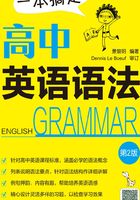
四、 形容词的种类
1. 描述性形容词
描述性形容词(descriptive adjective)描述它所修饰的名词或代词的性质或状态。
 exciting books 令人激动的书
exciting books 令人激动的书
 a smart and hardworking student 一个聪明、勤奋的学生
a smart and hardworking student 一个聪明、勤奋的学生
 exciting、smart、hardworking 是描述性形容词,描述名词 books 和 student。
exciting、smart、hardworking 是描述性形容词,描述名词 books 和 student。
◇ Last week Mabel bought a round glass table. 上周美博买了一张圆玻璃桌。
 round 是描述性形容词,glass 是名词作形容词用,表示材料。
round 是描述性形容词,glass 是名词作形容词用,表示材料。
2. 专有形容词
如果一个形容词是从一个专有名词衍生出来,就称为专有形容词(proper adjective),要以大写字母开头。
 a Danish singer 一名丹麦歌手
a Danish singer 一名丹麦歌手
 an Italian restaurant 一家意大利餐馆
an Italian restaurant 一家意大利餐馆
 Danish 和 Italian 是分别从专有名词 Dane 和 Italy 衍生出来的专有形容词。
Danish 和 Italian 是分别从专有名词 Dane 和 Italy 衍生出来的专有形容词。
◇ This beautiful little British girl is Kate, your new classmate. 这位美丽的英国小姑娘叫凯特,是你们的新同学。
 beautiful 和 little 是描述性形容词;British 是专有形容词。
beautiful 和 little 是描述性形容词;British 是专有形容词。
3. 所有格形容词/所有格限定词
❶ 当所有格代词(possessive pronoun),放在名词前面修饰名词时,就具有形容词的作用或限定作用,这样的所有格代词即为形容词性物主代词,也可称为(代词)所有格形容词或(代词)所有格限定词(possessive adjective/possessive determiner),包括 my、his、her、its、our、their、whose、your。
❷ 名词后面加上所有格符号(’)和字母 s 的词(即’s),也属于所有格形容词。
 my rocket 我的火箭
my rocket 我的火箭
 Jane’s two new airplanes 珍的2架新飞机
Jane’s two new airplanes 珍的2架新飞机
◇ Whose flowers look better than Sue’s? 谁的花比苏的花还漂亮?
 所有格形容词 Sue’s 后面省略了 flowers。
所有格形容词 Sue’s 后面省略了 flowers。
4. 指示形容词
指示形容词(demonstrative adjective)包括 this、that、these、those。这些词用在名词前,起形容词的作用。指示形容词用来表示所指的是哪一个(哪一些)东西或人物,因此也称为指示限定词(demonstrative determiner)。
 this huge wind power farm
this huge wind power farm
这家很大的风力发电厂
 that new geothermal electric power plant
that new geothermal electric power plant
那所新建的地热发电站
 these Japanese singers
these Japanese singers
这些日本歌手
 those antique American cars
those antique American cars
那些美国古董汽车
◇ This miniskirt is a little cheaper than that pink shirt.这条超短裙比那条粉红色的裙子便宜一些。
◇ Amy Ring played a very interesting role in that movie. 艾咪·瑞盈在那部电影里扮演一个非常有趣的角色。
5. 表示数量的形容词
❶ 表示不定数量的代词 some、any、many、much、a few、a little 等也可作形容词,修饰名词(如 some people)。请参见p.39<七、不定代词>。
❷ 数词可置于名词前作形容词(numbers as adjectives),数词包括基数词(cardinal number)和序数词(ordinal number)两类。句型为“数词+名词”。
❸ 基数词(one、two)表明人、物、动物等的数量。序数词(first、second)表明人或东西一个接一个的顺序。
 three fluffy kittens 3只毛茸茸的小猫
three fluffy kittens 3只毛茸茸的小猫
 the forth week of November 11月的第4周
the forth week of November 11月的第4周
6. 名词性形容词
❶ 有时候名词可以用来修饰其他名词,当作形容词用,构成复合名词(名词+名词)。
 a race track 一条跑道
a race track 一条跑道
 a war movie 一部战争影片
a war movie 一部战争影片
◇ Grace bought a Chinese glass vase. 葛蕾丝买了一个中国的玻璃花瓶。
 Chinese 是专有形容词,表示来源;glass 是名词性形容词,表示材料。
Chinese 是专有形容词,表示来源;glass 是名词性形容词,表示材料。
比较
 a beautiful shop 一家漂亮的商店
a beautiful shop 一家漂亮的商店
 a beauty shop 一家美容院
a beauty shop 一家美容院
 beauty shop 是复合名词(名词+名词)。
beauty shop 是复合名词(名词+名词)。
❷ 在“名词+名词”结构中,即使后一个名词用了复数形式,第1个名词也要用单数,而且不能用所有格形式,因为第1个名词用作形容词,而形容词并没有单复数形式的变化,也没有所有格形式。
 a shoe store → two shoe stores 鞋店
a shoe store → two shoe stores 鞋店
 a race track → two race tracks 跑道
a race track → two race tracks 跑道
❸ 如果 woman 或 man 是复合名词的一部分,而修饰的另一个名词是复数,则要用复数 women 或 men作名词性形容词。
 two women doctors=two female doctors 2个女医生
two women doctors=two female doctors 2个女医生
 two men nurses=two male nurses 2名男护士
two men nurses=two male nurses 2名男护士
 three women generals=three female generals 3名女将军
three women generals=three female generals 3名女将军
7. 复合形容词
❶ 由一个以上的词所构成的形容词,称作复合形容词,用在名词前时,常用连字号(hyphen)连接,以避免造成混淆。
 an old-fashioned hat 一顶旧式帽子(形容词+分词)
an old-fashioned hat 一顶旧式帽子(形容词+分词)
 a three-year-old girl 一个3岁大的女孩(数词+名词+形容词)
a three-year-old girl 一个3岁大的女孩(数词+名词+形容词)
 a five-story building 一幢5层高的大楼(数词+名词)
a five-story building 一幢5层高的大楼(数词+名词)
 a ten-day trip 一次10天的旅程(数词+名词)
a ten-day trip 一次10天的旅程(数词+名词)
比较
“复合形容词+名词”与“形容词+复合名词”。
 an old-car salesperson = a salesperson who sells old cars 一个卖旧车的推销员
an old-car salesperson = a salesperson who sells old cars 一个卖旧车的推销员
 形容词 old 只修饰第1个名词 car,而整个复合形容词 old-car 修饰名词 salesperson。
形容词 old 只修饰第1个名词 car,而整个复合形容词 old-car 修饰名词 salesperson。
 an old car salesperson = an old salesperson who sells cars 一个上了年纪卖汽车的推销员
an old car salesperson = an old salesperson who sells cars 一个上了年纪卖汽车的推销员
 名词 car 修饰 salesperson,构成复合名词,而形容词 old 修饰整个复合名词 car salesperson。
名词 car 修饰 salesperson,构成复合名词,而形容词 old 修饰整个复合名词 car salesperson。
❷ 复合形容词作定语置于名词之前时,通常要有连字号,而同样的修饰词如果不作定语,就不要连字号。
 part-time teachers 兼职老师=teachers who work part time (part time 作状语修饰动词)
part-time teachers 兼职老师=teachers who work part time (part time 作状语修饰动词)
 fire-resistant curtains 防火窗帘= curtains that are fire resistant (fire resistant 置于系动词之后作主语补语)
fire-resistant curtains 防火窗帘= curtains that are fire resistant (fire resistant 置于系动词之后作主语补语)
❸ 复合形容词中的名词不用复数形式。
 three two-door cars 3辆两门的汽车
three two-door cars 3辆两门的汽车
 ten three-year-old girls 10个3岁大的女孩
ten three-year-old girls 10个3岁大的女孩
◇ My husband and I take a two-hour walk almost every day. 我先生和我几乎每天都要散步2小时。
提示
foreign language teachers 和 foreign languages school。
❶ foreign language 之间不要连字号;language 通常不用复数,无论后面修饰的名词是单数还是复数。
 a foreign language teacher 1名外语老师
a foreign language teacher 1名外语老师
 three foreign language teachers 3名外语老师
three foreign language teachers 3名外语老师
❷ 但“一所外语学校”可以说 a foreign languages school(美式英语),也可以说 a foreign language school(英式英语)。
8. 疑问形容词
whose、what、which 这3个词用在名词前就是疑问形容词(interrogative adjective)或称疑问限定词(interrogative determiner)。
◇ Whose diamond shoes were in the news? 被报道的是谁的钻石鞋子?
◇ What color is Claire going to dye her hair? 克莱儿打算把她的头发染成什么颜色?
 当可供选择的数量未知时,用 what 比用 which 更自然。
当可供选择的数量未知时,用 what 比用 which 更自然。
◇ Which color is Claire going to dye her hair, red or brown? 克莱儿打算把她的头发染成哪一种颜色,红色还是褐色?
 当可供选择的数量有限、已知,要用 which。
当可供选择的数量有限、已知,要用 which。
9. 分词形容词
1) 分词形容词的位置
❶ 分词形容词指动词的-ing和-ed形式,它们在句中的位置与其他形容词相同,可以在名词前作定语,也可以在系动词后作主语补语(即表语)。
◇ Brook wrote an interesting grammar book. (名词前)
布露可编写了一本十分有趣的语法书。
◇ That book, The King of Swing, is interesting. (系动词后)
那本《摇摆之王》非常有趣。
❷ 一些分词形容词只能用于名词之后,相当于定语从句。
 people applying for US citizenship
people applying for US citizenship
=people who are/were applying for US citizenship
申请加入美国国籍的人
 the issue discussed yesterday
the issue discussed yesterday
=the issue that was discussed yesterday
昨天讨论过的议题
 Items Lost and Found(惯用语)
Items Lost and Found(惯用语)
失物招领
2) 分词形容词的用法
❶ -ing 分词有主动意义,而-ed分词有被动意义。
 the losing team 打输的队伍
the losing team 打输的队伍
 the lost wedding ring 被丢失的结婚戒指
the lost wedding ring 被丢失的结婚戒指
◇ Sue finally found her lost cellphone in her shoe.(遗失的)
苏最后在她的鞋子里找到了丢失的手机。
❷ 一般来说,描述某人的感觉、表情,要用-ed分词。描述引起这种感觉的人、东西、环境、事件,要用-ing分词。
 a frightened child 受惊的孩子
a frightened child 受惊的孩子
 a confused professor 感到困惑的教授
a confused professor 感到困惑的教授
 a tired student 疲倦的学生
a tired student 疲倦的学生
 a frightening movie 令人惊恐的影片
a frightening movie 令人惊恐的影片
 a confusing professor 令人困惑的教授
a confusing professor 令人困惑的教授
 a tiring trip 令人疲倦的旅途
a tiring trip 令人疲倦的旅途
◇  Sam was not surprising by/at the score on his English exam.
Sam was not surprising by/at the score on his English exam.
 Sam was not surprised by/at the score on his English exam.
Sam was not surprised by/at the score on his English exam.
山姆对他的英语考试分数并没有感到惊奇。
 以-ed结尾的形容词用来描述人的感觉;Sam 感到不惊奇,要用-ed形式。
以-ed结尾的形容词用来描述人的感觉;Sam 感到不惊奇,要用-ed形式。
◇  The confused magic tricks of the short clown were very amused.
The confused magic tricks of the short clown were very amused.
 The confusing magic tricks of the short clown were very amusing.
The confusing magic tricks of the short clown were very amusing.
那位矮个子小丑令人困惑的魔术非常逗人笑。
 -ed 分词用来描述人经历的情感,无生命之物(tricks)没有情感,不用表情感的-ed分词(confused, amused)来描述。
-ed 分词用来描述人经历的情感,无生命之物(tricks)没有情感,不用表情感的-ed分词(confused, amused)来描述。
◇ “Please don’t go there!” Joan shouted in a worried tone.裘恩忧虑地叫喊,“请不要去那里!”
 Joan感到忧虑。
Joan感到忧虑。
3) 分词构成的复合形容词
分词与其他词组合构成复合形容词,分词通常在复合词词尾。复合形容词用在名词之前时,要用连字号连接。
 English-speaking countries 讲英语的国家
English-speaking countries 讲英语的国家
 a rarely-performed opera 一场极其精彩的歌剧
a rarely-performed opera 一场极其精彩的歌剧
 a fast-growing industry 一个发展迅速的产业
a fast-growing industry 一个发展迅速的产业
 a short-lived television series 一部昙花一现的电视连续剧
a short-lived television series 一部昙花一现的电视连续剧